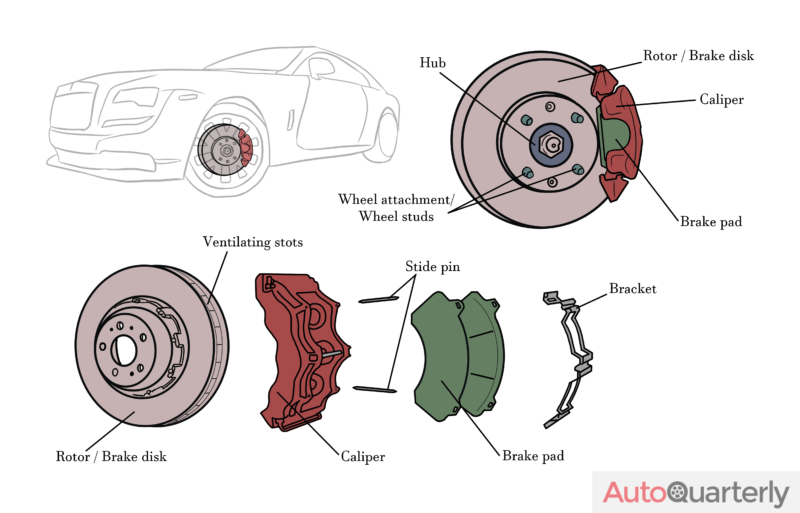Brake calipers are a key part of your car’s braking system. Most modern cars have disc brakes on at least the two front wheels. Some also have them on the back wheels. With this system, the car’s wheels are attached to metal discs called rotors which spin along with the wheels. Brake calipers are necessary in order for you to bring the vehicle to a stop. If you want to learn more about your car or be able to troubleshoot problems, understanding how brake calipers work is important.
How are brake calipers constructed?

The caliper fits over the brake rotor, the metal disc to which the wheel is attached. The brake pads are attached to the caliper. When you hit the brake pedal, brake fluid from the master cylinder creates hydraulic pressure which pushes the pistons in the brake caliper. The brake pads then work with the brake rotor to slow the car down or bring it to a stop. Since the rotor is attached to the wheels, they slow or stop together.
Types of calipers
There are two main types of brake calipers: fixed and floating. Fixed calipers, as the name suggests, remain in place on each side of the rotor and don’t move at all. They perform better but are more expensive.
On the other hand, floating calipers move in and out in relation to the rotor. In this case, the piston is inside the rotor and it pushes the whole brake caliper when the brakes are applied. Friction is created from the brake pads on both sides of the rotor.
There are also some super high performance fixed brake calipers which are used in specialized vehicles. They can contain as many as six pairs of pistons. They are extremely expensive so you won’t see them in consumer vehicles.
Motorcycle and truck brake calipers
Different vehicles will have different calipers. Large motorcycles tend to have disc brakes on the front and the brake calipers are joined to the forks. Given their lighter weight, motorcycles often need up to four pistons to engage the brakes.
Meanwhile, many pickup trucks and sports utility vehicles are manufactured with floating brake calipers. Some vehicle owners will modify them after purchase with different equipment. This is necessary if modifications are added which make the vehicle heavier. It may, therefore, need more power to make it stop. Technicians, therefore, increase the surface area between the rotor and calipers to help lessen the heat.
Brake caliper problems
Properly functioning brakes are key to the safety of drivers, passengers, and other road users. Any problems with brake calipers should, therefore, be addressed as quickly as possible to prevent accidents.
If you notice your car pulling to one side, this is a sign that one of the calipers is seizing up. You will need to troubleshoot the problem or take the car to a professional to ensure it is working properly.
One of the things you should check for is tightness. If your brake calipers are locking up while you are driving, it could be because the screws in which they are mounted are too tight. The calipers may be gripping the brakes too hard and causing it to turn.
You should also check for dirt and rust, as you would with any other part of the car. Your brake calipers can get accumulate lots of dust and dirt over time. Check for mud or bits of plant matter that may need to be removed. If the calipers are corroding they may need to be replaced since removing rust can weaken the part. Dust and rust can stop the pistons from moving properly and this causes locking.
Simple wear and tear from years of use can also cause part of the braking system to malfunction. Check for this if you have problems.


